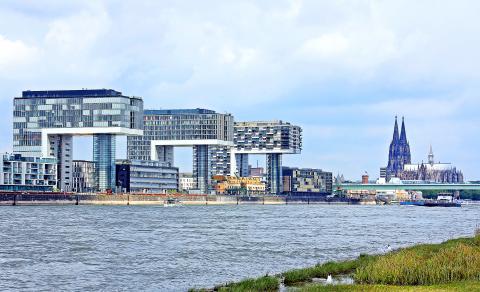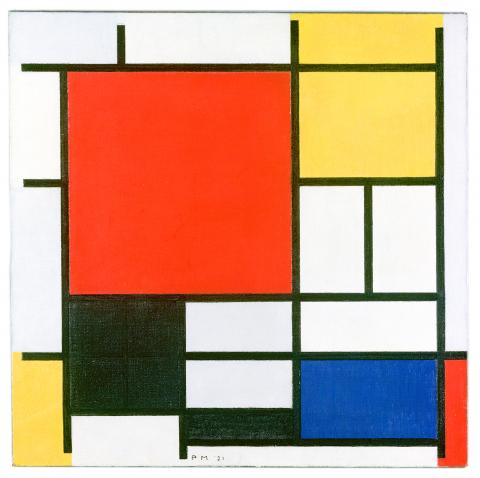You often hear in Taiwan people complaining of unsightly surroundings and an ugly environment, with box-like, concrete, soulless buildings — the “much-admired” Republic of China “aesthetic” — compared to traditional Qing-era architecture or Japanese colonial period architecture such as Japanese-style wooden bungalows or Western-style buildings combining Baroque elements.
It is possible to see white, boxy buildings throughout the world, in what used to be known as the “international style” that originated in Germany’s Bauhaus movement. Back then, the Bauhaus square-ish buildings were regarded as avant garde.
The word “Bauhaus” combines the German “bau” (to build) and “haus” (house). It was the name of a design institute established in Weimer, in eastern Germany, in 1919 — exactly a century ago — by the architect Walter Gropius (1883-1969).

Photo: Pixabay
照片: Pixabay
In Europe at the time, the idea that “ornamentation is a crime” had taken hold: that is, any ostentatious ornamentation on architecture or design was done for the benefit of the monarchy or aristocracy, and the more decorous a building was, the more it meant that the craftsmen working on it had been exploited.
Compared to the ostentatious, somber, meticulously detailed traditional architecture of the time, with its commemorative function, being built of stone to ensure survival into perpetuity, the simpler Bauhaus style emphasized utility, simplicity and reproducibility, which could be used by ordinary people and mass produced on an industrial scale. The school building (photo 2) designed by Gropius and the staff and students of the Bauhaus school after it relocated to Dessau in 1925 is an exemplar of this style. The essence of the “less is more” principle stated by Ludwig Mies van der Rohe (1886-1969), the school’s last principal, is still discernible in the simple, clean designs of Apple and Muji products today.
Gropius regarded architecture as a “total” work of art (Gesamtkunstwerk), including painting, interior design, furniture, textiles and performance, and brought artists and craftsmen from all these disciplines under one roof to study in the school. The modern approach to teaching art and design retains vestiges of the foundations laid by Bauhaus even today. With this cross-pollination of ideas and styles, we can see the influence of French Cubism and Dutch Neoplasticism (De Stijl, utilizing form and strong colors, with monochrome shapes consisting of straight horizontal and vertical lines filled with primary colors, as in photo 3) in Bauhaus architecture.

Photo: Wikimedia Commons
照片:維基共享資源
The end of Bauhaus came in 1933 at the hands of the Nazis, who criticized it for promoting internationalism, and of being antithetical to German nationalism and pro-communist. The Nazis also believed that the flat roofs favored by Bauhaus derived from Jewish design, and was unsuitable for the climate in Germany, where it often rained and snowed.
Chased out by the Nazis, the teachers and students of the Bauhaus school moved to America, where they would take up teaching positions in architecture institutes in Harvard and Chicago, their students ensuring the “international style” would be adopted the world over. The UN Secretariat Building in New York and the glass Pyramide du Louvre in Paris were both influenced by the glass Curtain Wall architectural design devised by the Bauhaus school. The white, box-like buildings of the international style have become part of the global architectural vocabulary, even if its expression is sometimes debased and soulless. The influence of Bauhaus is everywhere, ubiquitous to the extent that it is sometimes difficult to recognize it, similar to the difficulty in distinguishing the origins of a stranger who has no discernible accent.
(Translated by Paul Cooper)

Photo: Wikimedia Commons
照片:維基共享資源
在台灣,常有人抱怨放眼周遭,盡是醜陋的環境、水泥方塊毫無特色的建築,相較於清朝古建築以及日治時期的建築—日式木造平房、融合西洋巴洛克風格的洋樓,「中華民國美學」真是令人不敢恭維。
其實在當時,全世界都在蓋這種白色方盒子,名曰「國際風格」,輾轉源自德國的「包浩斯」(Bauhaus),而包浩斯的方塊建築當初是很前衛的。
「Bauhaus」,是由德文「bau」(建造)和「haus」(房屋)結合起來的,這是一所設計學院,一九一九年由建築師葛羅培斯(一八八三~一九六九)在德國東部的威瑪創立,距今正好一百週年。
當時歐洲有一派意識形態認為「裝飾即罪惡」—建築和設計的那些繁複裝飾,都是為王公貴族服務,因此裝飾越多,對工匠的剝削就越大。
因此,相對於傳統建築的華麗、沉重、多細節、以石材追求不朽的紀念性,包浩斯明快而輕盈,強調「實用、簡約、體系化」,要讓所有人民都能夠使用,並可工業化大量生產。包浩斯一九二五年遷校至德紹後,葛羅培斯等師生所設計的校舍即為代表【圖二】。包浩斯最後一任校長密斯(一八八六~一九六九)更提出了「Less is more.」(少即是多)的原則,現今蘋果電子產品、無印良品的簡潔風格,也可以看到傳承自包浩斯的精神。
葛羅培斯將建築視為綜合藝術,結合了繪畫、室內設計、家具、織品、劇場等,因此網羅這些領域的藝術家和工匠來訓練學生,現今的藝術設計教育,皆不脫包浩斯所奠定的基礎。這樣的跨領域思維,讓我們在包浩斯建築中,可以看到法國的立體派以及荷蘭風格派的影響(風格派將造型與顏色濃縮為水平與垂直線條、三原色與黑白,例如【圖三】)。
包浩斯最後在一九三三年被納粹全面封殺,理由是包浩斯鼓吹國際主義—因此是反德國的、共產黨的;包浩斯的平屋頂也被指控為猶太主義設計,因它不適合德國多雨雪的氣候。
包浩斯的師生於是輾轉來到美國,任教於哈佛、芝加哥等建築學院,徒子徒孫的影響力讓「國際風格」更無遠弗屆。美國紐約的聯合國秘書處大樓、法國羅浮宮的玻璃金字塔等,都受到包浩斯玻璃帷幕牆結構的影響。國際風格的白色方盒子更成為全球的語彙,甚至流於庸俗化——它們無所不在,因此不感到其存在,就像是「沒有口音」,無法分辨這是什麼地方、你從哪裡來。
(台北時報林俐凱)

Have you ever dreamed of hiking Taiwan’s majestic Mt. Jade or visiting Peru’s breathtaking Machu Picchu? These adventures sound amazing, but there’s something you should know about first: “altitude sickness.” This condition strikes when you climb to a higher elevation too quickly. The higher you go, the thinner the air becomes, making it harder for your body to absorb oxygen. The symptoms usually begin within hours of reaching high altitudes — about 2,500 meters or higher. You might experience headaches, dizziness, nausea, shortness of breath, or extreme fatigue. These symptoms can last for several days. The severity of altitude sickness varies

★ Bilingual Story is a fictionalized account. 雙語故事部分內容純屬虛構。 “Get in. It’s pouring.” She slid into the back seat, drenched and silent. “Tissues?” the driver asked. “No, thank you,” she said. Water beaded off her hair, ran from her coat, and made a small lake on the vinyl. She kept her head down, long black strands clinging to her face. “Where to?” She gave an address. “Funeral?” he asked as they slipped into the Xinhai Tunnel, rain fading to a hollow drum. She glanced up, puzzled. “No. Why?” “Crematorium’s about the only thing here.” He caught her eyes in the mirror.

A: In addition to boyband Energy’s concerts, Taiwan’s first major male dance revue has attracted attention. B: Several South Korean male dance revues and Australia’s Thunder from Down Under often tour Taiwan. Now Taiwan’s first all-male revue has finally appeared. A: According to the Liberty Times, Muscle High: A Male Dance Revue from Taiwan, featuring 13 hunks, opened last month and will run until Sept. 14. B: The rise of “hunk fever” in recent years has even caused a trend of working out in Asia. A: Let’s go to the Taipei Music Center’s Sub Livehouse for the show. A:

A: Any fun events happening this weekend? B: Boyband Energy’s concerts and Taiwan’s first major male dance revue have both sparked anticipation recently. A: Energy staged a comeback last year — 15 years after they disbanded — and they’re now more popular than ever. B: Their megahit “Friday Night” even won Song of the Year at the Golden Melody Awards. A: To pay tribute to the Queen of Pop Madonna, they added her choreography of 16 continuous jump squats to their music video, prompting a “16-squat challenge” that went viral across Taiwan. Do you wanna try it out? A: